Master 2021
In 2021 was er het bijzonder hoge aantal van zestien inzendingen in de categorie Master. Daarbij voerde de faculteit Civiele Techniek en Geowetenschappen van de TU Delft de boventoon. Maar er waren ook inzendingen van andere Delftse faculteiten, zoals Bouwkunde en 3mE én van de Universiteit Twente en de TU Eindhoven. Vanwege het grote aantal hoogkwalitatieve inzendingen zijn in 2021 twee 2e prijzen uitgereikt.
« terug naar StudentenSTAALprijs 2021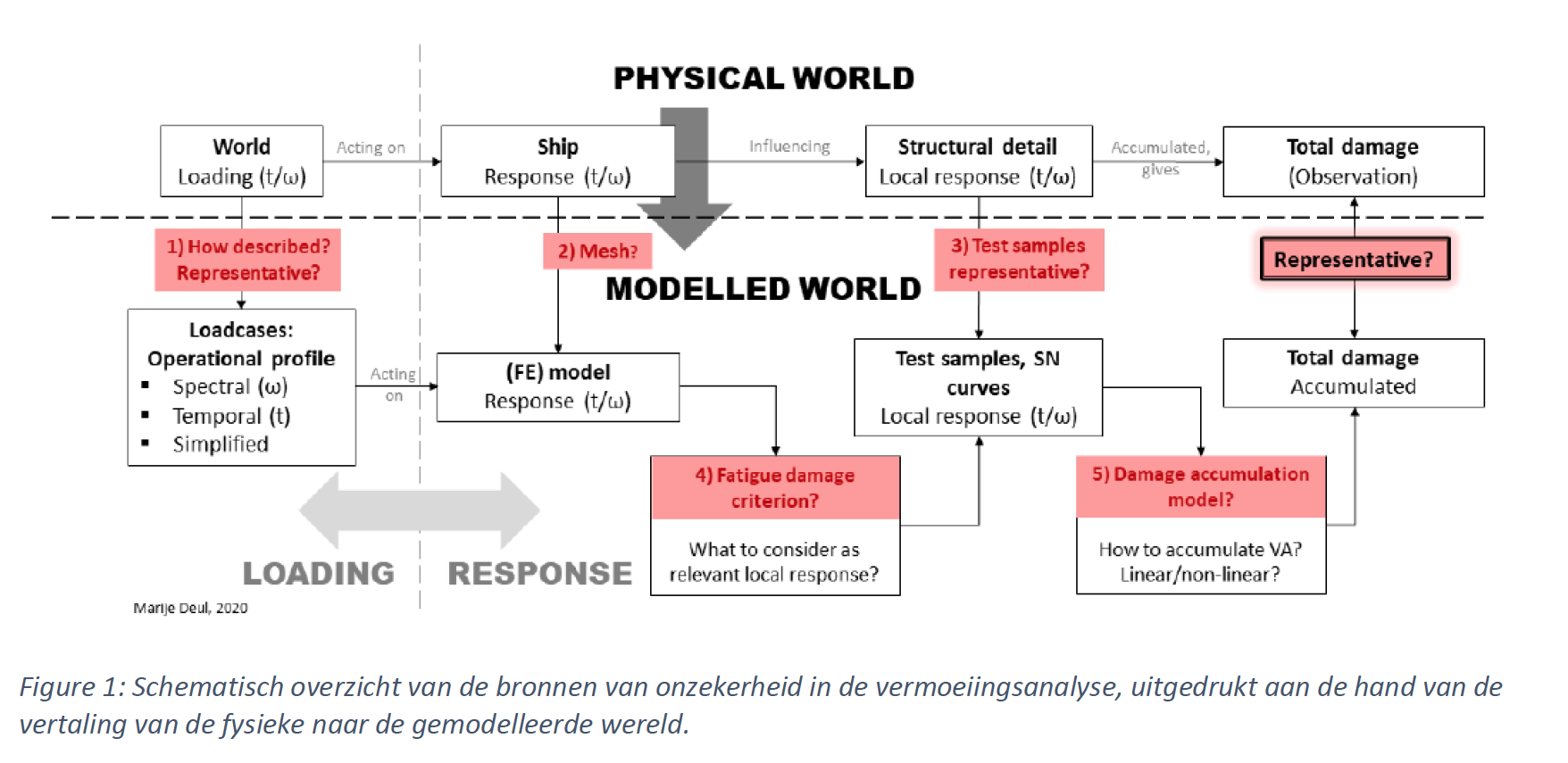 1e prijs: Marije Deul (Technische Universiteit Delft & DMO) - Fatigue damage accumulation in steel welded joints, subject to (random) variable amplitude loading conditions
1e prijs: Marije Deul (Technische Universiteit Delft & DMO) - Fatigue damage accumulation in steel welded joints, subject to (random) variable amplitude loading conditions
Schepen worden van oudsher geconstrueerd uit, en gebouwd met, staal. Dit komt onder andere voort uit de relatieve lage kosten en de vertrouwdheid in de sector met het materiaal. Voor scheepsconstructies is de vermoeiingslevensduur een leidende limit-state: de geometrie wordt aangepast of het plaatmateriaal wordt opgedikt om lokale spanningsconcentraties te verlagen tot onder de kritische grens wanneer de voorspelde levensduur niet toereikend is. Echter blijkt deze analyse onderhevig aan veel onzekerheid. Deze onzekerheid wordt vertaald naar conservatisme en zodoende naar zwaardere constructies. Omdat voor schepen het gewicht invloed heeft op de beladingscapaciteit en stabiliteit is een sterk conservatieve benadering ongewenst. Twee bronnen van onzekerheid die nauw verbonden zijn, zijn de spanningsberekening (Fatigue Damage Criterion) en de schadeaccumulatieregel, tevens het onderwerp van deze masterthesis.
Probleemanalyse
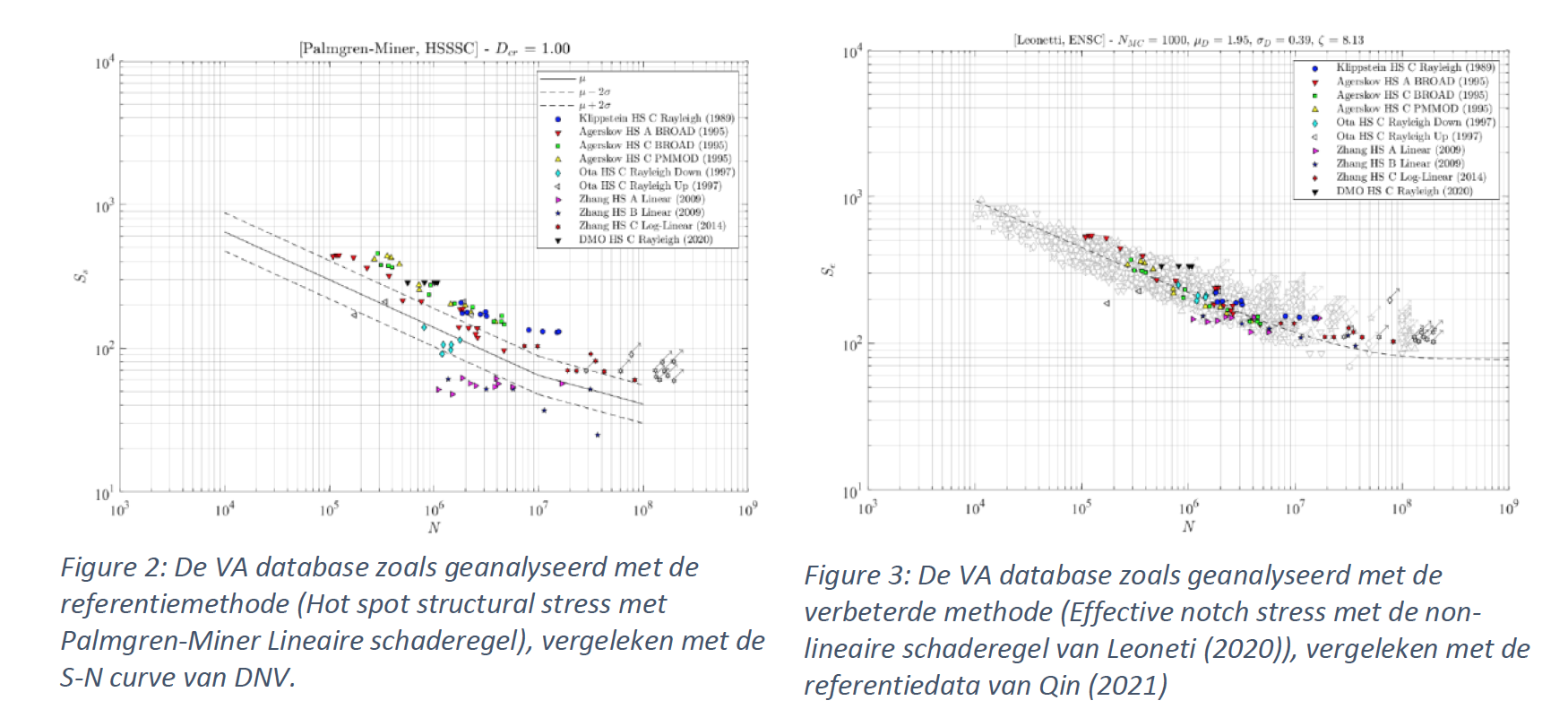 De schadeaccumulatieregel van Palmgren en Miner is breed geaccepteerd in de standaarden. Het gebrek van deze regel ligt in de onkunde om het effect van de belastinghistorie op de toekomstige schade te beschrijven. Er wordt aangenomen dat de schade zich met een constante snelheid ontwikkelt, hetgeen door experimenten (en breukmechanica) wordt tegengesproken. Het voordeel van de regel is dat het relatief eenvoudig te implementeren is en een lineaire veiligheidsfactor (soms tot een factor 5 reducerend) toelaat. Figuur 2 (zie afstudeerrapport red.) toont dat, voor een variatie aan geometrieën, belastinghistories, datasets en staalsoorten (allen constructie staal), de spreiding bij het gebruik van deze regel groot is. In deze referentiecasus is het Hot Spot Structural Stress Concept gebruikt om de spanningsconcentratiefactor te bepalen. Dit concept gebruikt beperkt de lokale informatie over de lasgeometrie. Als verbetering wordt een non-lineair schade accumulatiemodel (Leonetti, 2020) gecombineerd met het Effective Notch Stress Concept (semi-analytisch; den Besten, 2015). Dit accumulatiemodel beschrijft een afnemende vermoeiingslimiet: hoe meer schade er is, hoe gevoeliger het detail is voor lagere amplitudes en hoe sneller de schade ontwikkelt. Hiernaast modelleert het Effective Notch Stress Concept de lokale geometrie en dus het effect van plaatdikte, lashoek, keelhoogte etc. Het resultaat ziet u in Figuur 3 (zie afstudeerrapport red): de spreiding is significant afgenomen. De levensduur-spreidingsindex neemt af van 1:1.28 tot 1:1.13.
De schadeaccumulatieregel van Palmgren en Miner is breed geaccepteerd in de standaarden. Het gebrek van deze regel ligt in de onkunde om het effect van de belastinghistorie op de toekomstige schade te beschrijven. Er wordt aangenomen dat de schade zich met een constante snelheid ontwikkelt, hetgeen door experimenten (en breukmechanica) wordt tegengesproken. Het voordeel van de regel is dat het relatief eenvoudig te implementeren is en een lineaire veiligheidsfactor (soms tot een factor 5 reducerend) toelaat. Figuur 2 (zie afstudeerrapport red.) toont dat, voor een variatie aan geometrieën, belastinghistories, datasets en staalsoorten (allen constructie staal), de spreiding bij het gebruik van deze regel groot is. In deze referentiecasus is het Hot Spot Structural Stress Concept gebruikt om de spanningsconcentratiefactor te bepalen. Dit concept gebruikt beperkt de lokale informatie over de lasgeometrie. Als verbetering wordt een non-lineair schade accumulatiemodel (Leonetti, 2020) gecombineerd met het Effective Notch Stress Concept (semi-analytisch; den Besten, 2015). Dit accumulatiemodel beschrijft een afnemende vermoeiingslimiet: hoe meer schade er is, hoe gevoeliger het detail is voor lagere amplitudes en hoe sneller de schade ontwikkelt. Hiernaast modelleert het Effective Notch Stress Concept de lokale geometrie en dus het effect van plaatdikte, lashoek, keelhoogte etc. Het resultaat ziet u in Figuur 3 (zie afstudeerrapport red): de spreiding is significant afgenomen. De levensduur-spreidingsindex neemt af van 1:1.28 tot 1:1.13.
Scheepsconstructies als subset van staalconstructies
Binnen het onderzoek lag de focus op belastinghistories die typisch zijn voor scheepsconstructies. Immers, de onzekerheden in de analyse staan los van de onzekerheden in de invoer (zie ook de vele standaarden die generiek geschreven zijn voor stalen constructies). Met het gebruiken van een andere belastinghistorie is het werk uitstekend toepasbaar voor een grote variëteit aan variabel belaste stalen constructies.
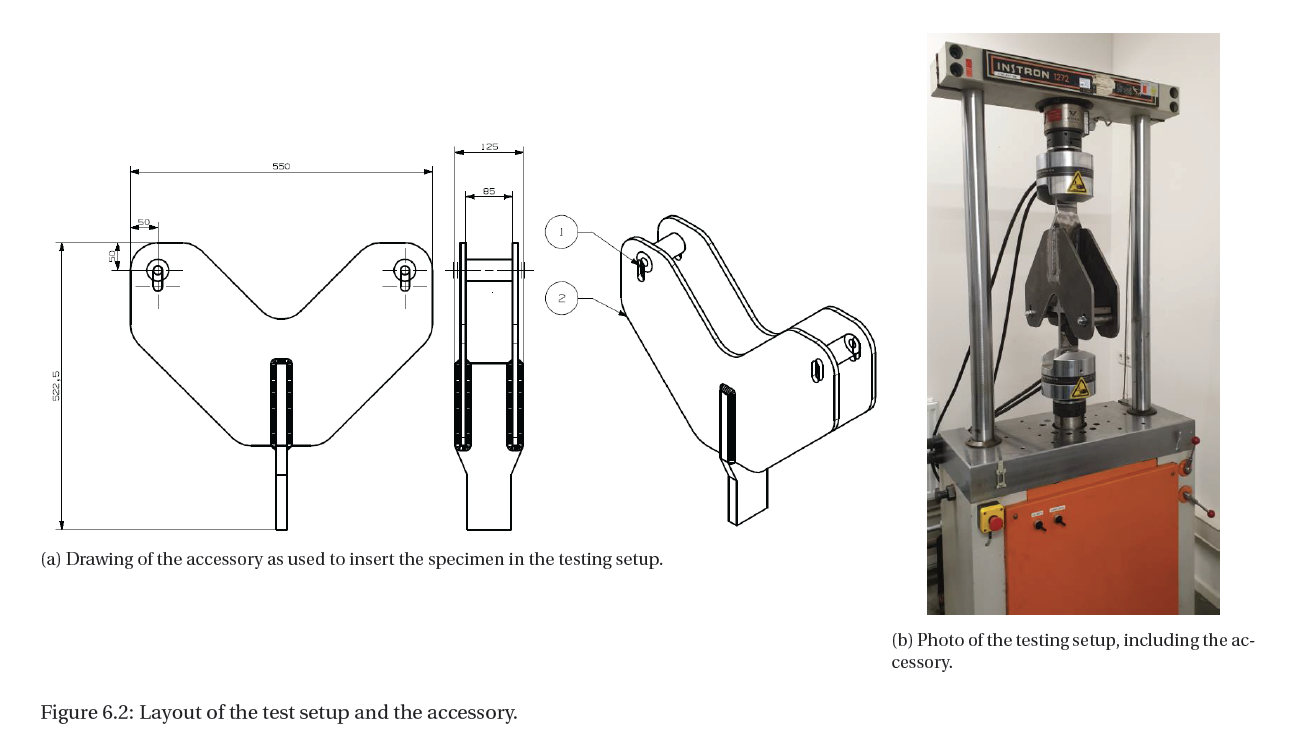 Het oordeel van de jury:
Het oordeel van de jury:
‘Vermoeiing’ is een onderwerp dat de laatste tijd steeds meer in de belangstelling staat. Niet verwonderlijk dat dit vaak als afstudeeronderwerp wordt gekozen, zo ook door de inzenders voor de studentenSTAALprijs. Deze afstudeerder heeft een uiterst diepgaand wetenschappelijk onderzoek verricht dat er direct boven uitspringt. De brede aanpak naast de diepgang van de studie ontlokt bewonderende reacties van de jury. Het onderzoek gaat diep in op de theorie van vermoeiing en is met name toegepast op vermoeiingsvoorspellingen bij marineschepen. Het onderzoek getuigt van beheersing van de materie, wiskunde en programmatuur en het vermogen op grond van kritische analyses nieuwe inzichten toe te voegen.
De jury komt superlatieven tekort bij het omschrijven van de waardering voor dit onderzoek. ‘Ubercategorie analyse’ en zelfs ‘kandidaat grondlegger van nieuwe theorieën’, zijn kwalificeringen die niet anders kunnen betekenen dan een afgetekende eerste prijs!
The assessment of the jury:
“Fatigue” is a topic that has received increasing attention recently. It is not surprising that this is often chosen as a graduation topic, including by the entrants for the studentenSTAALprijs. This graduate has conducted an extremely in-depth scientific research that stands out immediately. The broad approach in addition to the depth of the study elicited admiring reactions from the jury. The research explores the theory of fatigue in depth and has been applied in particular to fatigue predictions in naval vessels. The research demonstrates mastery of the subject matter, mathematics and software and the ability to add new insights on the basis of critical analyses.
The jury lacks superlatives when describing the appreciation for this research. 'Ubercategory analysis' and even 'candidate founder of new theories' are qualifications that can mean nothing more than a signed first prize!
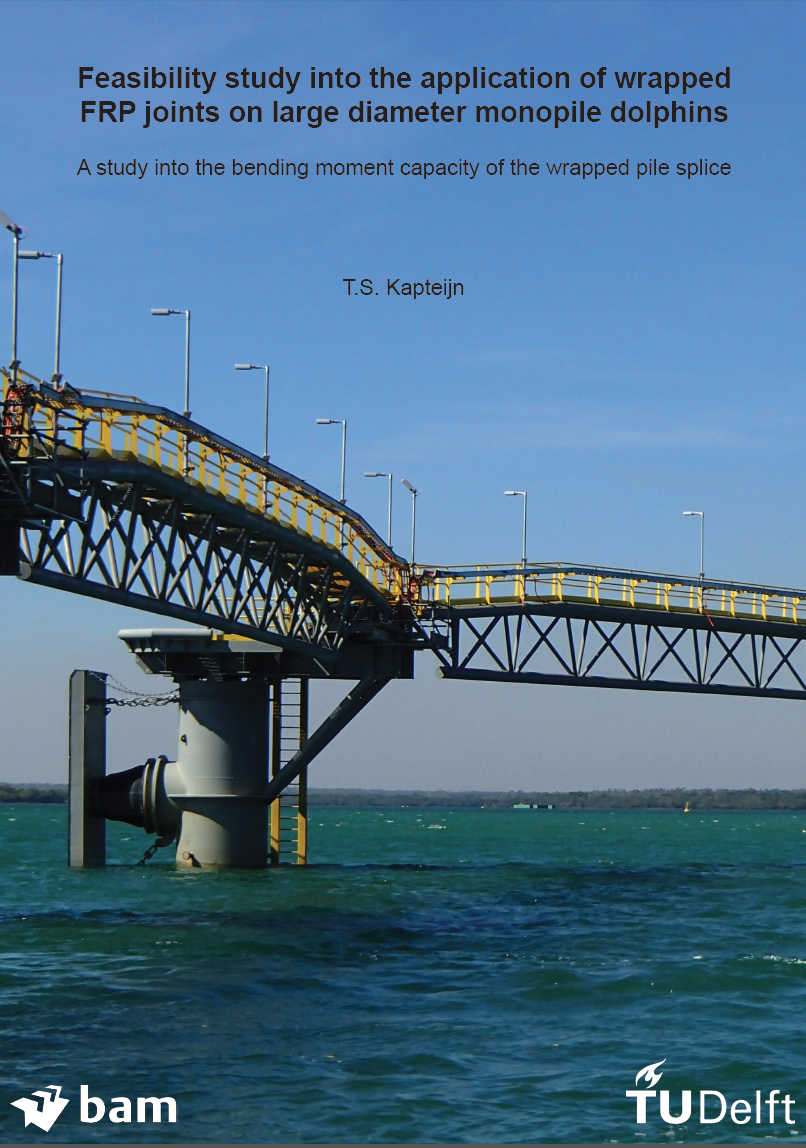 2e prijs: Tim Kapteijn (Technische Universiteit Delft & BAM Infraconsult) - Feasibility study into the application of wrapped FRP joints on large diameter monopile dolphins - A study into the bending moment capacity of the wrapped pile splice
2e prijs: Tim Kapteijn (Technische Universiteit Delft & BAM Infraconsult) - Feasibility study into the application of wrapped FRP joints on large diameter monopile dolphins - A study into the bending moment capacity of the wrapped pile splice
Fatigue resistant Wrapped Fibre Reinforced Polymer (wFRP) joints may have large potential in replacing the welded tubular connections in marine structures where steel design is governed by the fatigue limit state (FLS). In large diameter steel monopile dolphins the structural dimensions exceed the sizes for which spirally welded tubes can be produced. The monopile dolphin is designed with steel cans of 3 meter length connected by fatigue sensitive circumferentially butt welded splice joints. Application of an uniaxial wFRP joint on this large diameter monopile dolphin may greatly improve the utilisation in fatigue limit state allowing an overall steel thickness reduction. As steel has a significant carbon footprint, reducing the amount of steel in monopile dolphin design by considering innovative.
For small scale welded pile splices the uniaxial Wrapped Fibre Reinforced Polymer (wFRP) joint may be a serious alternative considering the static bending moment capacity. With a relatively short wrapping length a high bending moment capacity is reached. Based on the strong size effect observed in upscaling the wFRP joint Finite Element (FE) model, application of the uniaxial wFRP joint on a single splice in a large diameter monopile dolphins seems unfeasible with current joint design. For the reference structure 40% of the steel material can be saved by an overall thickness reduction when all welded pile splices are replaced by a wFRP joint, but considering the needed overlap lengths in order to transfer bending moments this solution converges to a monopile dolphin totally wrapped by FRP.
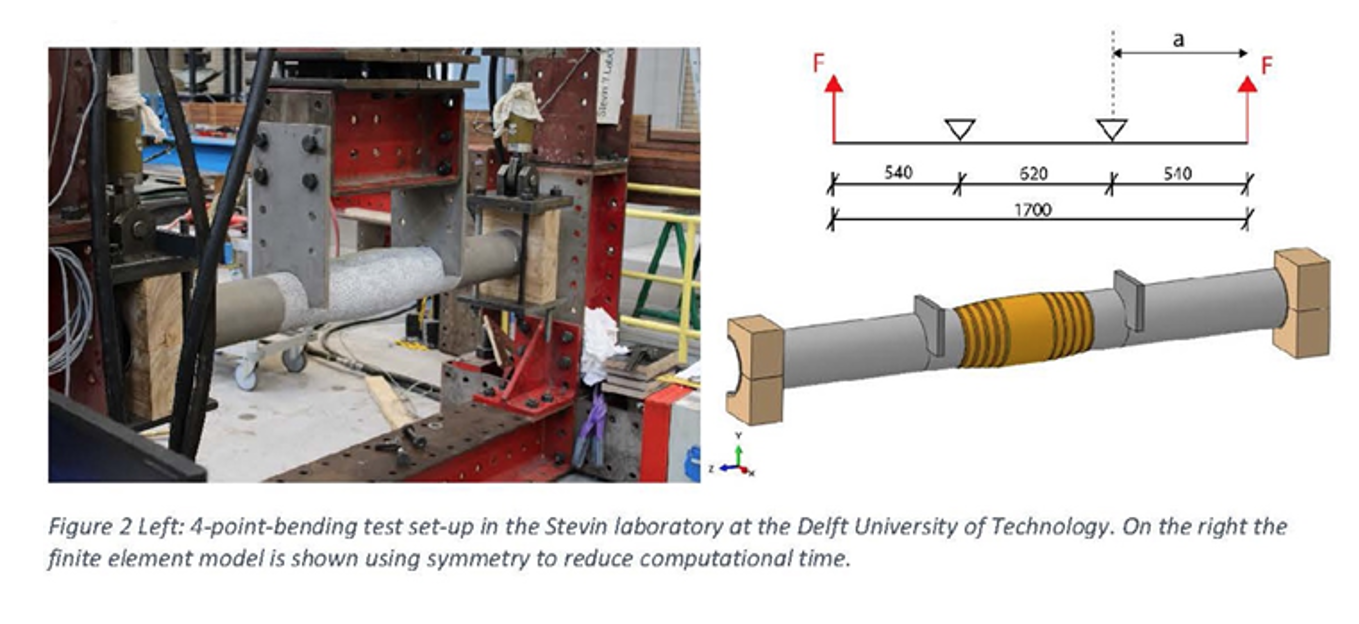 Het oordeel van de jury:
Het oordeel van de jury:
Ook deze afstudeerder heeft het onderwerp ‘vermoeiing’ bij de horens gevat. Met het toekomstbeeld van mega windmolenparken op zee is dit onderzoek uiterst actueel. Vermoeiing speelt een grote rol bij windmolens op zee en iedere kans op levensduurverlenging en of materiaalbesparing heeft direct effect op de terugverdientijd. Vooral de gedachtegang achter dit onderzoek van samenwerking tussen materialen is aantrekkelijk. Niet het voorspellen van de mate van vermoeiing staat centraal, maar de manier waarop dit probleem te elimineren is. Door de gevoelige lasverbindingen te vervangen door een Wrapped Fibre Reinforced Polymer verbinding kan niet alleen materiaal worden bespaard, maar is ook het probleem vermoeiing vermeden. ‘Win-win’ situatie die de producenten van windmolens met open armen zal ontvangen. Verregaande inzichten in FRP-toepassingen in staalconstructies leiden tot besparingen, maar vragen ook om meer kennis. Dit soort onderzoek draagt daar aan bij.
‘Hybride verbindingen: interessant’, ‘Maatschappelijk relevant’, ‘Draagt bij aan oplossingen voor de klimaatproblematiek’, vat de jury blij samen.
The assessment of the jury:
This graduate has also taken the subject of 'fatigue' by the horns. With the vision of the future of mega wind farms at sea, this research is extremely topical. Fatigue plays a major role in offshore wind turbines and any chance of life extension or material savings has a direct effect on the payback period. The thinking behind this research into collaboration between materials is especially attractive. It is not the prediction of the degree of fatigue that is central, but the way in which this problem can be eliminated. By replacing the sensitive welded joints with a Wrapped Fiber Reinforced Polymer joint, not only can material be saved, but the problem of fatigue is also avoided. A 'win-win' situation that will be welcomed by the wind turbine producers with open arms. Far-reaching insights into FRP applications in steel structures lead to savings, but also require more knowledge. This kind of research contributes to that.
'Hybrid connections: interesting', 'Socially relevant', 'Contributes to solutions for the climate problem', the jury happily summarizes.
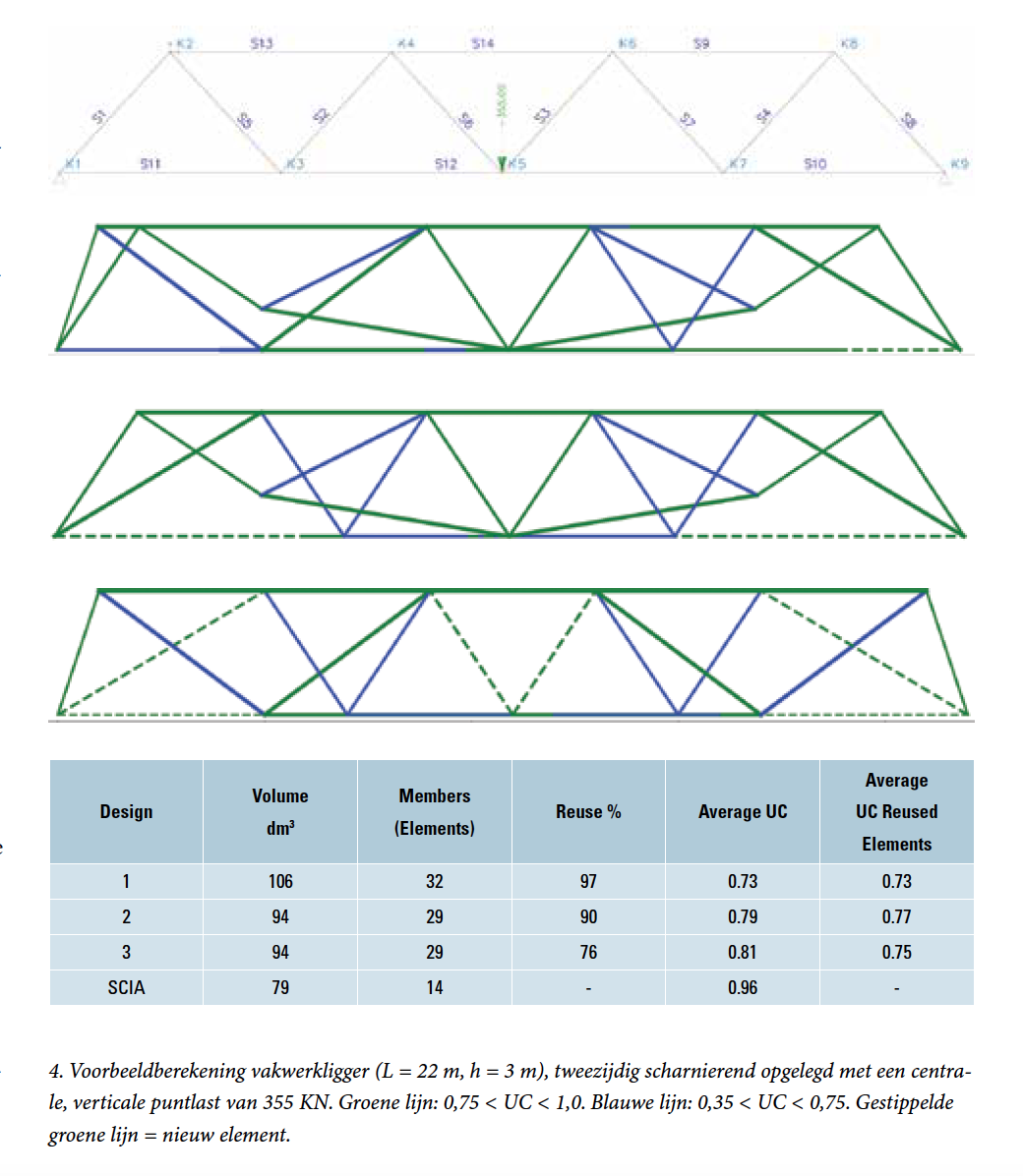 2e prijs: Thijs van Gelderen (Technische Universiteit Delft & Aronsohn) - Truss topology optimization with reused steel elements (vakwerk topologie optimalisatie met hergebruikte stalen elementen)
2e prijs: Thijs van Gelderen (Technische Universiteit Delft & Aronsohn) - Truss topology optimization with reused steel elements (vakwerk topologie optimalisatie met hergebruikte stalen elementen)
The building industry is a large contributor to the emission of greenhouse gasses, the production of steel and cement alone is responsible for 10% of all global emissions. Combined with scarcity of raw materials, recycling and reuse is becoming more important. Over 90% of all steel is collected and recycled. However, much energy is required for processing the steel. Reuse of structures and components requires less processing and thus less energy and could be much more beneficial than recycling. Many challenges arise when designing with reuse as a result of which it is still rarely put in practice. Buildings are not designed for reuse making disassembly and reconstruction difficult. Organized documentation of materials and elements of existing buildings for reuse is not widely put in practice making reuse less accessible. A lack of confidence of quality of reclaimed elements holds clients back. Transport and storage of reused elements is difficult and expensive and designing with reuse involves a complex design process. The latter is simplified in this paper by answering the following main research question:
• "To what extend can a topology optimization method be used to simplify the complex design process with reused elements for the design of steel trusses?"
To answer this question a tool has been developed for the design of steel trusses with reused elements. Designs are generated by performing a topology optimization. Volume of structures is minimized and average unity check and reuse percentage maximized. The member adding scheme of He et al. (2019), based on the ground structure method of Dorn (1964), is used as a basis and adapted and extended with new functions. An existing method for designing with reused elements of Brütting et al. (2019b) is used for inspiration. The member adding scheme is a discrete topology optimization method in which size, connectivity and number of elements is variable.
The developed optimization method consists of a number of iterating steps.
The optimization tool contains many parameters for values of penaltie’s and threshold numbers. Varying these parameters can result in a variance of designs. Preference could be given to designs with least volume, least number of members, highest percentage of reuse or highest average unity check. Architectural appearance could also be of importance.
In conclusion, the design tool is useful for designing with reused elements. The discrete topology optimization method of He et al. (2019) proved to be an effective method to automatize and simplify the design process. Designs may not be global optima but many design alternatives can be presented to the user. The developed optimization method is an improvement of the method for designing with reused elements of Brütting et al. (2019b). With limited complexity and large availability of elements, designs have been generated with an average unity check close to the maximum unity check. With increasing complexity effectiveness of the design tool decreases. Complexity is influenced by grid size, number of possible elements, availability of individual and different elements and number of point loads.
Applicability of the design tool should be increased by including constraints for buckling, nodal instability, intersection and overlap of elements. Self-weight should be included either. An analysis of a reduction of embodied carbon, energy and construction costs could give insight in attractiveness of designing with reused elements.
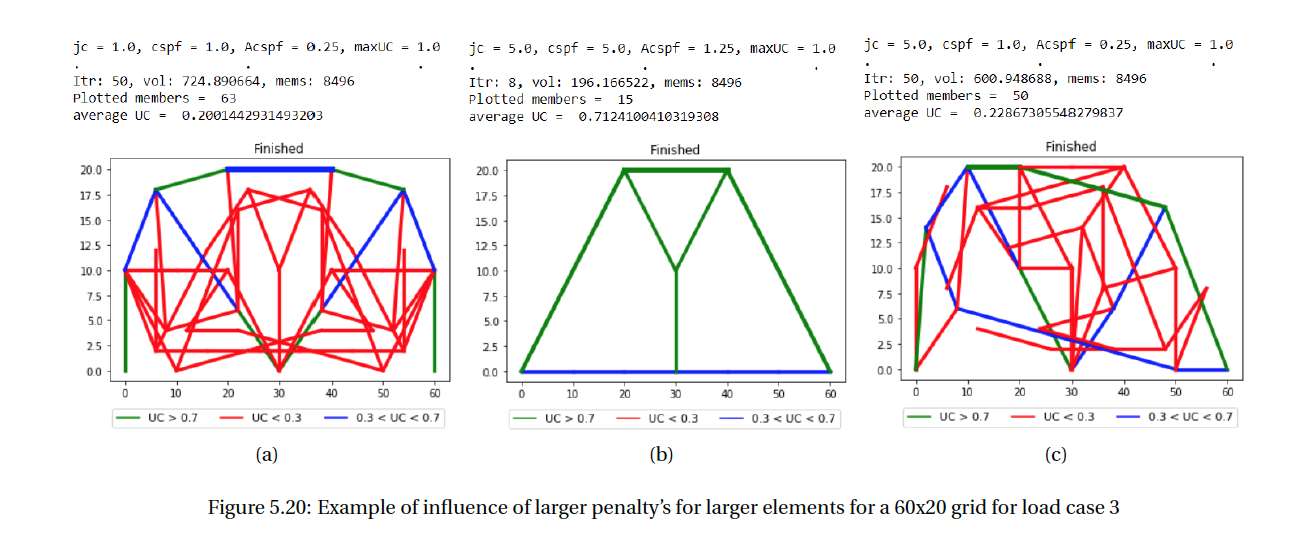 Het oordeel van de jury:
Het oordeel van de jury:
Het thema duurzaamheid en hergebruik van staalconstructies staat centraal in dit onderzoek. Het onderzoek spitst zich toe op de ontwikkeling van een database met gebruikte elementen en hun eigenschappen.
Ontwerpers kunnen hun ontwerp aanpassen aan de beschikbaarheid van de elementen of kunnen alternatieve ontwerpen realiseren door verschillende variabelen te kiezen. Voor het stimuleren van hergebruik en de mogelijkheden ervan breed toegankelijk te maken, is de ontwikkeling van een database een welkome toevoeging. Om alle variabelen mee te kunnen wegen wacht nog wel een grote uitdaging. ‘Stoer’, ‘Nuttig onderzoek’, ‘Vernieuwend’, ‘Duurzaam’, een tweede prijs waardig concludeert de jury.
The assessment of the jury:
The theme of sustainability and reuse of steel structures is central to this research. The research focuses on the development of a database of elements used and their properties.
Designers can adapt their design according to the availability of the elements or can realize alternative designs by choosing different variables. The development of a database is a welcome addition to encouraging reuse and making its possibilities widely accessible. Taking all variables into account is for designers still a major challenge. The jury concluded: 'Sturdy', 'Useful research', 'Innovative', 'Sustainable', worthy of a second prize.



